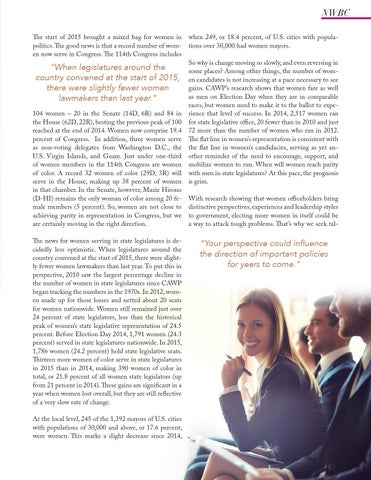NWBC The start of 2015 brought a mixed bag for women in politics. The good news is that a record number of women now serve in Congress. The 114th Congress includes
“When legislatures around the country convened at the start of 2015, there were slightly fewer women lawmakers than last year.” 104 women – 20 in the Senate (14D, 6R) and 84 in the House (62D, 22R), besting the previous peak of 100 reached at the end of 2014. Women now comprise 19.4 percent of Congress. In addition, three women serve as non-voting delegates from Washington D.C., the U.S. Virgin Islands, and Guam. Just under one-third of women members in the 114th Congress are women of color. A record 32 women of color (29D, 3R) will serve in the House, making up 38 percent of women in that chamber. In the Senate, however, Mazie Hirono (D-HI) remains the only woman of color among 20 female members (5 percent). So, women are not close to achieving parity in representation in Congress, but we are certainly moving in the right direction. The news for women serving in state legislatures is decidedly less optimistic. When legislatures around the country convened at the start of 2015, there were slightly fewer women lawmakers than last year. To put this in perspective, 2010 saw the largest percentage decline in the number of women in state legislatures since CAWP began tracking the numbers in the 1970s. In 2012, women made up for those losses and netted about 20 seats for women nationwide. Women still remained just over 24 percent of state legislators, less than the historical peak of women’s state legislative representation of 24.5 percent. Before Election Day 2014, 1,791 women (24.3 percent) served in state legislatures nationwide. In 2015, 1,786 women (24.2 percent) hold state legislative seats. Thirteen more women of color serve in state legislatures in 2015 than in 2014, making 390 women of color in total, or 21.8 percent of all women state legislators (up from 21 percent in 2014). These gains are significant in a year when women lost overall, but they are still reflective of a very slow rate of change. At the local level, 245 of the 1,392 mayors of U.S. cities with populations of 30,000 and above, or 17.6 percent, were women. This marks a slight decrease since 2014,
when 249, or 18.4 percent, of U.S. cities with populations over 30,000 had women mayors. So why is change moving so slowly, and even reversing in some places? Among other things, the number of women candidates is not increasing at a pace necessary to see gains. CAWP’s research shows that women fare as well as men on Election Day when they are in comparable races, but women need to make it to the ballot to experience that level of success. In 2014, 2,517 women ran for state legislative office, 20 fewer than in 2010 and just 72 more than the number of women who ran in 2012. The flat line in women’s representation is consistent with the flat line in women’s candidacies, serving as yet another reminder of the need to encourage, support, and mobilize women to run. When will women reach parity with men in state legislatures? At this pace, the prognosis is grim. With research showing that women officeholders bring distinctive perspectives, experiences and leadership styles to government, electing more women in itself could be a way to attack tough problems. That’s why we seek tal-
“Your perspective could influence the direction of important policies for years to come.”
